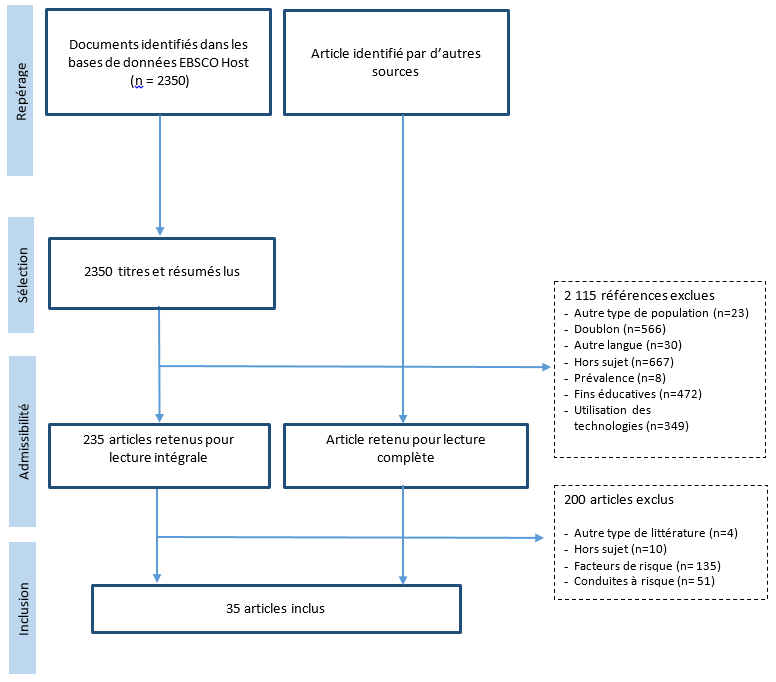Liste de références sur les pratiques en intervention précoce et l’utilisation d’Internet
Objectif 3
Identifier les modèles d’intervention précoce novateurs, prometteurs ou basés sur des données probantes ciblant les jeunes de 12 à 25 ans présentant des comportements à risque au regard des pratiques de l’utilisation d’internet (UI), en s’appuyant sur une revue narrative critique des études évaluatives ayant été menés sur le sujet.
Objectif 3.c - seuils à risque spécifiques aux pratiques de l’utilisation d’Internet et les outils de repérage et de détection de ces seuils
Anderson, E. L., Steen, E., et Stavropoulos, V. (2017). Internet use and Problematic Internet Use: A systematic review of longitudinal research trends in adolescence and emergent adulthood. International Journal of Adolescence and Youth, 22(4), 430-454.
Frangos, C. C., Frangos, C. C., et Sotiropoulos, I. (2012, July). A meta-analysis of the reliabilty of Young‘s Internet Addiction Test. In Proceedings of the World Congress on Engineering (Vol. 1, pp. 368-371). London, United Kingdom: World Congress on Engineering.
Jelenchick, L. A., Eickhoff, J., Christakis, D. A., Brown, R. L., Zhang, C., Benson, M., et Moreno, M. A. (2014). The Problematic and Risky Internet Use Screening Scale (PRIUSS) for adolescents and young adults: Scale development and refinement. Computers in human behavior, 35, 171-178.
Koo, H. J., Han, D. H., Park, S. Y., et Kwon, J. H. (2017). The structured clinical interview for DSM-5 Internet gaming disorder: Development and validation for diagnosing IGD in adolescents. Psychiatry investigation, 14(1), 21.
Kuss, D. J., et Griffiths, M. D. (2011). Excessive online social networking: Can adolescents become addicted to Facebook?. Education and Health, 29(4), 63-66.
Lemos, I. L., Cardoso, A. et Sougey, E. B. (2016). Validity and reliability assessment of the Brazilian version of the game addiction scale (GAS). Comprehensive Psychiatry, 67, 19‑25. doi:10.1016/j.comppsych.2016.01.014
Nazlıgül, M. D., Baş, S., Akyüz, Z., et Yorulmaz, O. (2018). Internet gaming disorder and treatment approaches: A systematic review. Addicta: The Turkish Journal On Addictions, 5, 13-35.
Pamuk, M., et Atli, A. (2016). Development of a problematic mobile phone use scale for university students: validity and reliability study. Dusunen Adam, 29(1), 49-59.
Siciliano, V., Bastiani, L., Mezzasalma, L., Thanki, D., Curzio, O. et Molinaro, S. (2015). Validation of a new Short Problematic Internet Use Test in a nationally representative sample of adolescents. Computers in Human Behavior, 45, 177‑184. doi:10.1016/j.chb.2014.11.097
Sigerson, L. et Cheng, C. (2018). Scales for measuring user engagement with social network sites: A systematic review of psychometric properties. Computers in Human Behavior, 83, 87‑105. doi:10.1016/j.chb.2018.01.023
Sun Jae Moon, Jin Seub Hwang, Jae Yup Kim, Shin, A. L., Seung Min Bae et Jung Won Kim. (2018). Psychometric Properties of the Internet Addiction Test: A Systematic Review and Meta-Analysis. CyberPsychology, Behavior & Social Networking, 21(8), 473‑484. doi:10.1089/cyber.2018.0154
Tejeiro, R. A., Espada, J. P., Gonzalvez, M. T., et Christiansen, P. (2016). Psychometric properties of the Problem Video Game Playing scale in adults. Revue Européenne de Psychologie Appliquée/European Review of Applied Psychology, 66(1), 9-13.
Wong, U. et Hodgins, D. C. (2014). Development of the game addiction inventory for adults (GAIA). Addiction Research & Theory, 22(3), 195‑209. doi:10.3109/16066359.2013.824565
Objectif 3.d - modèles d’intervention précoce novateurs, prometteurs ou basés sur des données probantes ciblant les jeunes de 12 à 25 ans ayant une utilisation d’Internet à risque
Bağatarhan, T. et Siyez, D. M. (2017). Programs for Preventing Internet Addiction during Adolescence: A Systematic Review. Addicta: The Turkish Journal on Addictions, 4(2), 257‑265. doi:10.15805/addicta.2017.4.2.0015
Chun, J., Shim, H. et Kim, S. (2017). A Meta-Analysis of Treatment Interventions for Internet Addiction Among Korean Adolescents. CyberPsychology, Behavior & Social Networking, 20(4), 225‑231. doi:10.1089/cyber.2016.0188
Friedrich, R. R., Polet, J. P., Schuch, I., et Wagner, M. B. (2014). Effect of intervention programs in schools to reduce screen time: a meta‐analysis. Jornal de pediatria, 90(3), 232-241.
Gioka, S., Kefaliakos, A., Ioannou, A., Mechili, A., et Diomidous, M. (2014, July). Hospital based Treatment for Internet Addicts. In ICIMTH (pp. 279-282).
Good, B. et Fang, L. (2015). Promoting Smart and Safe Internet Use Among Children with Neurodevelopmental Disorders and Their Parents. Clinical Social Work Journal, 43(2), 179‑188. doi:10.1007/s10615-015-0519-4
Jago, R., Edwards, M. J., Urbanski, C. R., et Sebire, S. J. (2013). General and specific approaches to media parenting: a systematic review of current measures, associations with screen-viewing, and measurement implications. Childhood obesity, 9(s1), S-51.
King, D. L., et Delfabbro, P. H. (2014). Internet gaming disorder treatment: a review of definitions of diagnosis and treatment outcome. Journal of clinical psychology, 70(10), 942-955.
King, D. L., et Delfabbro, P. H. (2014). The cognitive psychology of Internet gaming disorder. Clinical psychology review, 34(4), 298-308.
King, D. L., Delfabbro, P. H., Wu, A. M. S., Doh, Y. Y., Kuss, D. J., Pallesen, S., … Sakuma, H. (2017). Treatment of Internet gaming disorder: An international systematic review and CONSORT evaluation. Clinical Psychology Review, 54, 123‑133. doi:10.1016/j.cpr.2017.04.002
Koo, C., Wati, Y., Lee, C. C., et Oh, H. Y. (2011). Internet-addicted kids and South Korean government efforts: boot-camp case. Cyberpsychology, Behavior, and Social Networking, 14(6), 391-394.
Li, W. (2016). Mindfulness-Oriented Recovery Enhancement for Video Game Addiction in US Emerging Adults.
Liu, J., Nie, J. et Wang, Y. (2017). Effects of Group Counseling Programs, Cognitive Behavioral Therapy, and Sports Intervention on Internet Addiction in East Asia: A Systematic Review and Meta-Analysis. International Journal Of Environmental Research And Public Health, 14(12). doi:10.3390/ijerph14121470
Mishna, F., Cook, C., Saini, M., Wu, M. J., et MacFadden, R. (2011). Interventions to prevent and reduce cyber abuse of youth: A systematic review. Research on Social Work Practice, 21(1), 5-14.
Romo, L., Saleh, D., Scanferla, E., Coeffec, A., Cheze, N., et Taquet, P. (2017). La thérapie cognitivo-comportementale peut-elle être adaptée dans l’usage problématique des réseaux sociaux?. Journal de Thérapie Comportementale et Cognitive, 27(3), 99-109.
Throuvala, M. A., Griffiths, M. D., Rennoldson, M. et Kuss, D. J. (2018). School-based Prevention for Adolescent Internet Addiction: Prevention is the Key. A Systematic Literature Review. Current Neuropharmacology. doi:10.2174/1570159X16666180813153806
Vondrácková, P. et gabrhelík, R. (2016). Prevention of Internet addiction: A systematic review. Journal of Behavioral Addictions, 5(4), 568‑579. doi:10.1556/2006.5.2016.085
Wahi, G., Parkin, P. C., Beyene, J., Uleryk, E. M., et Birken, C. S. (2011). Effectiveness of interventions aimed at reducing screen time in children: a systematic review and meta-analysis of randomized controlled trials. Archives of pediatrics & adolescent medicine, 165(11), 979-986.
Winkler, A., Dörsing, B., Rief, W., Shen, Y., et Glombiewski, J. A. (2013). Treatment of internet addiction: a meta-analysis. Clinical psychology review, 33(2), 317-329.
Wölfling, K., Beutel, M. E., Dreier, M., et Müller, K. W. (2014). Treatment outcomes in patients with internet addiction: a clinical pilot study on the effects of a cognitive-behavioral therapy program. BioMed research international, 2014.
Zhong, X., Zu, S., Sha, S., Tao, R., Zhao, C., Yang, F., ... et Sha, P. (2011). The effect of a family-based intervention model on Internet-addicted Chinese adolescents. Social Behavior and Personality: an international journal, 39(8), 1021-1034.
Objectif 3.e - recommandations d’experts en matière de meilleures pratiques en intervention précoce ciblant l’utilisation d’Internet à risque
Chen, K. H., Oliffe, J. L., et Kelly, M. T. (2018). Internet gaming disorder: an emergent health issue for men. American journal of men's health, 12(4), 1151-1159.
King, D. L., Delfabbro, P. H., Doh, Y. Y., Wu, A. M. S., Kuss, D. J., Pallesen, S., … Sakuma, H. (2018). Policy and Prevention Approaches for Disordered and Hazardous Gaming and Internet Use: an International Perspective. Prevention Science, 19(2), 233‑249. doi:10.1007/s11121-017-0813-1
Dernière mise à jour: 21 septembre 2020




